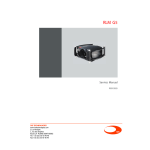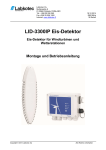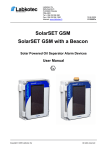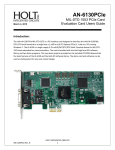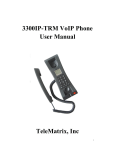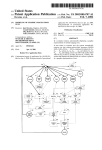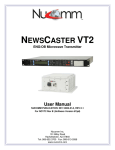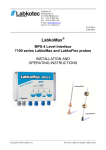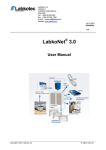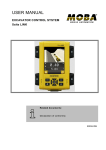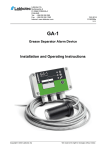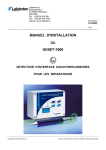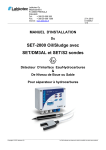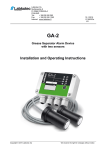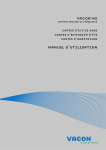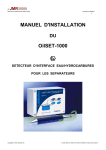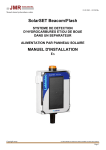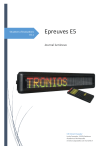Download LID-3300IP Ice Detector
Transcript
Labkotec Oy Myllyhaantie 6 FI-33960 Pirkkala, FINLAND Tel. +358 29 006 260 Fax +358 29 006 1260 Internet: www.labkotec.fi 19.12.2014 D80186Je 36 pages LID-3300IP Ice Detector Ice Detector for Wind Turbines and Meteorological Stations Installation and Operating Instructions Copyright © 2014 Labkotec Oy 1/36 LID-3300IP Ice Detector Installation and Operating Instructions D80186Je TABLE OF CONTENTS SUMMARY OF CHANGES AND NEW FUNCTIONALITIES ................................... 3 1 PRODUCT OVERVIEW ....................................................................................... 4 2 INSTALLATION ................................................................................................... 5 2.1 Installation and interfaces of LID-3300IP Control Unit ................................. 5 2.2 Power supply................................................................................................ 6 2.3 Installation of LID/ISD Ice Sensor ................................................................ 6 2.4 Connections between LID/ISD Ice Sensor and LID-3300IP Control Unit .... 7 2.5 Commissioning............................................................................................. 7 2.6 Lightning protection ...................................................................................... 8 3 LID-3300IP ICE DETECTOR IN OPERATION .................................................... 9 3.1 Operating modes.......................................................................................... 9 3.2 LID-3300IP Front Panel ............................................................................. 10 3.3 Use of different parameter settings ............................................................ 10 4 SERIAL INTERFACES: RS-232 AND OPTICAL FIBER ................................... 11 4.1 RS-232 Terminal Settings .......................................................................... 11 4.2 Serial Output - Streaming Mode Format .................................................... 13 4.3 Serial Output – Measurement and Configuration Menu ............................ 13 5 INTERNET WEB ACCESS ................................................................................ 17 5.1 Web UI - Header ........................................................................................ 18 5.2 Web UI – Status ......................................................................................... 18 5.3 Web UI - Raw command input ................................................................... 18 5.4 Web UI - Settings ....................................................................................... 18 5.5 Direct Web Access between PC and LID .................................................. 21 6 TECHNICAL SPECIFICATION .......................................................................... 23 7 REPAIR AND SERVICE .................................................................................... 24 8 ANNUAL MAINTENANCE ................................................................................. 24 APPENDIX A. STREAMING MODE OF SERIAL OUTPUT ................................... 25 APPENDIX B. PARAMETERS ............................................................................... 28 APPENDIX C. TERMINAL COMMANDS ............................................................... 31 APPENDIX D. SYSTEM CONNECTION DIAGRAM .............................................. 33 APPENDIX E. EVENT LOG MESSAGES .............................................................. 34 Symbols in this document Caution, risk of danger Caution, hot surface Copyright © 2014 Labkotec Oy 2/36 LID-3300IP Ice Detector Installation and Operating Instructions D80186Je SUMMARY OF CHANGES AND NEW FUNCTIONALITY The following table describes the latest changes and major new functionality in LID-3300IP Ice Detector and this user manual. Changes in LID-3300IP and LID/ISD User Manual More information in chapters Component certificate according to GL Rules and Guidelines – IV Industrial Services – Part 1 – “Guideline for the Certification of Wind Turbines”, Edition 2010 6. Technical Specification Certificate No. CC-GL-013A-2014. Results of functional safety analysis added. 6. Technical Specification Lightning protection principles added. Other connection diagrams modified accordingly. Chapter 2.6 Chapter 2.4, App. D New features added in LID-3300IP software version v1.40 - Event log for ice alarms, faults, parameter settings and other user actions - Clock incl. SNTP and DNS client - New user profile “Tester” - Cancelling of manual Ice Alarm Test in web UI - Command for manual test of fault relay Chapter 5.4, App. E Chapter 5.4, App. C Chapter 5.4 Chapter 5.2 Appendix C Recommendation of different parameter settings for different applications and use cases. Chapter 3.3 Checking of dirt and dust during annual maintenance added. Chapter 8 Minimum values of parameters P0 and P1 changed to 10 and 15 respectively. Appendix B Copyright © 2014 Labkotec Oy 3/36 LID-3300IP Ice Detector Installation and Operating Instructions 1 D80186Je PRODUCT OVERVIEW LID-3300IP (later referred to also as LID or LID Ice Detector) is an ice detector for wind turbines and meteorological stations. LID-3300IP Ice Detector consists of LID-3300IP Control Unit and LID/ISD Ice Sensor. LID monitors the icing weather conditions on-line and reports icing events through various interfaces. Ice alarm and other measurement information are available via 2 relay outputs, 2 analog outputs, front panel, serial output either as RS-232 or optical fiber interface and Web user interface. Ice detection of the LID/ISD Ice Sensor is based on an ultrasonic principle. Ultrasonic signal attenuates when ice is accumulated on the sensor wire. By default, LID starts to heat itself after an ice detection to get rid of the accumulated ice. Alarm levels and sensor heating, among other functions, can be controlled by user-configurable parameters. Certain factory parameters have been defined by the manufacturer, which allow start-up and operation without any additional definitions. This manual includes instructions for installation, commissioning and operating of the LID-3300IP Ice Detector. Labkotec products are designed to be safe when operated in the manner described in this manual. The safety of this product cannot be guaranteed if the product is used in any other way than is specified in this manual. Copyright © 2014 Labkotec Oy 4/36 LID-3300IP Ice Detector Installation and Operating Instructions 2 D80186Je INSTALLATION 2.1 Installation and interfaces of LID-3300IP Control Unit The enclosure of LID-3300IP is wall-mounted. Mounting holes are located in the base plate of the enclosure, beneath the mounting holes of the front cover. Interfaces and other important components of LID-3300IP Control Unit are described in the below list and picture. 1. 2. 3. 4. 5. 6. 7. 8. 9. 10. 11. 12. Power Sensor heating Ice Sensor signal Relay outputs Fault relay (normally energized = no fault) 5 = normally closed 6 = common contact 7 = normally open Ice Alarm relay (normally deenergized = no ice alarm) 8 = normally open 9 = common contact 10 = normally closed Analog outputs (source) Active current output 1 11 = Iout1+ 12 = Iout1Active current output 2 13 = Iout2+ 14 = Iout2Not in use at the moment Ethernet RJ-45 connector for Internet Web access RS-232 / Optical fiber serial interface selection jumper RS-232 D-connector Main fuse Fuse for sensor heating Fuse for sensor heating Copyright © 2014 Labkotec Oy 13. 14. 15. Connector for front panel flat cable Optical fiber converter module (RS2O). Tx connector (left), Rx connector (right) USB connector for software download 5/36 LID-3300IP Ice Detector Installation and Operating Instructions 2.2 D80186Je Power supply The device does not have a mains switch. During maintenance and service operations it has to be possible to switch off the main supply. Only an authorized electrician is allowed to install power supply cable to LID-3300IP control unit. The installation of power supply can be done by two alternative ways: - Permanent wiring: using a two pole mains switch (250 Vac 5 A), which isolates both lines (L1, N). Switch must be installed in the main power supply lines in the vicinity of LID-3300IP control unit. Copper wires 1.5 - 2.5 mm2 (AWG 16 - 13) can be connected to the power supply terminal of the control unit. - Plug connection: using supply cable with plug that can be disconnect from plug socket when necessary. Remember to tighten the strain relief of cable gland. LID-3300IP must always be connected to protective earth (PE). 2.3 Installation of LID/ISD Ice Sensor The LID/ISD Ice Sensor is designed for mounting on a weather mast. The preferred place for installation in a wind turbine is on top of the nacelle. The correct installation position is marked with an upwardspointing arrow label. The sensor should be mounted against the wind so that there is free airflow in front of the sensor. See the below figure for the preferred installation direction. Free air distance must be minimum 500 mm. Avoid installations where there is a possibility that the ice which accumulates to surrounding structures might reach the sensor. A standard delivery includes a mounting kit for installing the sensor on the weather mast. See the figure below. Other mounting options are also available on request. Copyright © 2014 Labkotec Oy 6/36 LID-3300IP Ice Detector Installation and Operating Instructions D80186Je Flammable materials or materials that may melt are not allowed to locate close to the sensor. The sensor body includes a 350W heating resistor. A temperature sensor T1 (ice sensor temperature) is located in the centre part of the sensor and temperature sensor T2 (ambient temperature) inside the connector of the sensor cable. A safety thermostat is also mounted inside the body of the sensor to break the heating circuit if the sensor temperature rises above +65 °C. 2.4 Connections between LID/ISD Ice Sensor and LID-3300IP Control Unit The cables connecting the ice sensor and control unit are included in the delivery. The standard length of the cables is 10 m. Only an authorized electrician is allowed to install heating cable between LID/ISD sensor and LID-3300IP control unit. NOTE! Additional measures regarding lightning protection might be needed according to IEC 61400-24. See also chapter 2.6 Lightning protection. NOTE! Make sure that high voltage cabling and equipment will not interfere ice detector system or cabling of ice detector. 2.5 Commissioning LID-3300IP is ready for operation when sensor and control unit are connected together and power is switched on in the control unit. However, it may be useful to do at least the following things right after the installation. 1. Check device parameters either via web or serial user interface and make sure they are according to factory settings. Adjust parameters if needed. 2. Define network settings for internet access via MENU 4 in serial interface. 3. Set site name via web or serial interface. 4. Generate an ice alarm with test button or cooling spray. Copyright © 2014 Labkotec Oy 7/36 LID-3300IP Ice Detector Installation and Operating Instructions 2.6 D80186Je Lightning protection Lightning protection for LID-3300IP Ice Detector Control Unit and LID/ISD Ice Sensor shall be done according to standard IEC 61400-24 “Wind turbines – Part 4: Lightning protection” when installed into a wind turbine. General principles for protecting ice detector system against overvoltage in case of lightning strike is presented in the above picture. Components in the picture are: 1. LID-3300IP Control Unit 2. Surge protection device 3. Automation cabinet 4. Metal tubes 5. LID/ISD Ice Sensor 6. Holder for ice sensor 7. Air termination rod Copyright © 2014 Labkotec Oy 8/36 LID-3300IP Ice Detector Installation and Operating Instructions 3 D80186Je LID-3300IP ICE DETECTOR IN OPERATION This chapter explains the basic operation of LID-3300IP. Serial and Web user interfaces are explained in different chapters. 3.1 Operating modes LID-3300IP operates in different modes which are explained below. SENSING MODE LID-3300IP continuously measures the signal level of the ice sensor. The maximum signal amplitude value can be defined by the user by parameter 2. By default, the signal value varies between 0 and 100. Ice signal value is visible in serial and web user interfaces, and available as continuous current message in the analog output. ICE DETECTED MODE When ice signal goes below a defined alarm level (set by parameter 0), LID goes to Ice detected –mode and gives an ice alarm. The delay of an ice alarm can be set by parameter 3. Ice alarm is visible in the Ice alarm LED of the front panel as well as serial and web interfaces. Ice relay energizes and closes contacts 8 and 9. Ice alarm and Ice detected mode are active during the Heating and Cooling phases that follow an ice alarm. Parameter 22 can be used to set a delay for ice alarm deactivation. It will keep the ice alarm active after the heating and cooling phase for the duration of the time delay. This is to prevent repetitive alarms during a long icing event. HEATING PHASE Right after the ice alarm is detected, sensor starts to heat itself to get rid of the accumulated ice. It is also possible to disable heating by parameter 12. The whole heating process can be controlled with parameters 12 – 18, 23 and 24. Default heating parameters shoud be useful enough for most weather conditions. Automatic heating is used to remove soft ice which has slowly accumulated over the sensor in light icing conditions. It does not generate an ice alarm. Automatic heating is controlled with parameters 23 and 24. COOLING PHASE When sensor is heated to the maximum heating temperature, LID moves to Cooling phase. Ice signal value is measured all the time and it should be close to the maximum after the Heating phase. Cooling phase has ended when sensor temperature is close to ambient temperature (parameter 20), or maximum cooling time (parameter 19) has exceeded, or sensor temperature has gone below 0 ºC. Ice alarm is released after the cooling period if ice signal value is above the alarm level. FAULT MODE LID indicates a fault or failure if there are problems in ice measurement, temperature measurements, heating or in other operations of the unit. Fault indication is visible in the Fault LED in the front panel, serial and web user interfaces and in the fault relay output. Please note that the Fault relay is normally energized, providing thus a Copyright © 2014 Labkotec Oy 9/36 LID-3300IP Ice Detector Installation and Operating Instructions D80186Je fail-safe operation. Depending on the fault, LID may continue operating otherwise normally or indicates a critical failure. E.g. ice measurement error is a critical failure but heating failure is not. Explanation of the fault codes in the serial interface are presented in Appendix A. 3.2 LID-3300IP Front Panel Indicator / button Meaning POWER Green light means power is on. No light means no power. ICE ALARM Red light means ICE ALARM. No light means NO ICE ALARM. HEATING Red light means HEATING is ON. No light means HEATING is NOT ON. FAULT Red light means FAULT is ON. No light means FAULT is NOT ON. TEST BUTTON Pushing the test button shortly will generate an ICE ALARM. Pushing the test button longer (about 10 seconds) will reset the device. 3.3 Use of different parameter settings Functionality of LID-3300IP Ice Detector system is configurable as described in chapter 3.1. All parameters as well as their default and valid values are described in Appendix B. “Parameters”. In general, parameters can be grouped to following categories: - Ice detection parameters (P0 - P6, P22) - Heating parameters (P12 - P20, P23, P24) - I/O parameters (P7 - P9) Default parameter values are configured to every device before delivery and they suite perfectly for most of the cases. Since icing is very different in different locations globally or even locally and in different times of the year, user may want to change parameter values to better suite his application. If parameter values are changed, Labkotec recommends to apply the following guidelines: Use case Recommended parameter values Stop wind turbine due to safety risk 30 < P0 > 70, P1 = P0 + 10 Start blade heating (anti-icing) 70 < P0 > 90, P1 = P0 + 10 P16, P17, P18 close to maximum Extreme icing conditions P0 > 60, P1 = P0 + 10 P16, P17, P18 close to maximum Please consult Labkotec when defining parameters for your application. Copyright © 2014 Labkotec Oy 10/36 LID-3300IP Ice Detector Installation and Operating Instructions 4 D80186Je SERIAL INTERFACES: RS-232 AND OPTICAL FIBER LID-3300IP Ice Detector is equipped by default with an RS-232 serial communication interface for configuration and connection to SCADA systems. When RS-232 interface is connected permanently to a SCADA system, please use an external powered galvanic isolator. Also, an optical fiber serial interface is available as an option. This requires an additional RS2O Converter module to be installed inside LID-3300IP Control Unit (item 14 in the lower picture in chapter 2.1. Only either of the interfaces can be used at a time. Selection of the used interface is done with the RS-232 / Optical fiber interface selection jumper (item 8 in the lower picture in chapter 2.1) as follows: 1. Switch off the power from LID-3300IP control unit 2. Open the cover of LID-3300IP control unit 3. Set selection jumper between • pins 1 and 2 (left and middle) for RS-232 • pins 2 and 3 (middle and right) for RS2O module 4. Connect cable(s) according to the above jumper selection: • RS-232 cable to RS-232 D-connector (item 9 in the lower picture in chapter 2.1) • Optical fibers to RS20 Converter module through the right side cable gland on LID-3300IP control unit 5. Close the cover of LID-3300IP 6. Connect RS-232 cable or optical fibre to system 7. Switch on the mains power 4.1 RS-232 Terminal Settings Ice signal value, eventual alarms and fault diagnostics can be obtained by using a PC equipped with an ordinary terminal program e.g. Tera Term. It’s also possible to change operational parameters with the terminal program. The following procedure describes serial port setting using freeware ‘Tera Term’ - terminal program. 1. Connect the RS-232 port of your PC to the RS-output D-connector on the LID-3300IP control unit. Use USB-to-RS converter if your PC is not equipped with an RS-232 port. 2. Start the terminal program and select Setup > Serial Port. Select the RS-232 (COM) port of your PC where the serial cable is connected. Copyright © 2014 Labkotec Oy 11/36 LID-3300IP Ice Detector Installation and Operating Instructions D80186Je 3. Make port settings as below and press OK. 4. Select Setup > Terminal and set Local echo and New-line settings as described below. Press OK. LID should start communicating with your PC as seen below. Finally change the terminal font from menu: Setup > Font. Choose e.g Courier New, regular, Size 9, to view as much text as possible in one window at a time. Now all the settings are ready for communication. 5. You can save the session for further use. Select Setup > Save setup… TERATERM. Copyright © 2014 Labkotec Oy 12/36 LID-3300IP Ice Detector Installation and Operating Instructions 4.2 D80186Je Serial Output - Streaming Mode Format Right after the connection to RS-232 serial output has been established, Ice Detector starts to send a data format through the connection. New values are reported once every 4 seconds. Example (variable length format with two temperature sensors): 08 -5.0 -5.5 *100 08 -5.5 -5.5 *100 08 -6.0 -6.0 *100 … There are three different output formats: - Variable length format (RSFORMAT 0) - Constant length format (RSFORMAT 1) - LID-3210 format (RSFORMAT 2) The output format is read with command RSFORMAT and set with command RSFORMAT <x>. In case parameter 4 (Number of temperature sensors) has been set to 1, ambient temperature value is not visible in the RS output. More detailed definitions of the output formats are presented in Appendix A. 4.3 Serial Output – Measurement and Configuration Menu RS-232 streaming mode can be interrupted at any time by pressing the Enter key. The following menu structure opens with self-explaining instructions. Please note that menus may vary between different software versions. The following screenshots describe the functionality of software version v1.30. RS-232 output returns to streaming mode either by pressing ‘q’ or automatically after 60 seconds. ENTERING COMMANDS All commands in the menus can be given in capital or small letters. In addition to the commands listed in the menus, e.g. the following commands are available. They can be entered in any menu view. - TEST The test command starts a manual ice alarm test. - HEAT The heat command starts manual heating. See Appendix C for a complete list of terminal commands. Copyright © 2014 Labkotec Oy 13/36 LID-3300IP Ice Detector Installation and Operating Instructions D80186Je MAIN MENU MENU 1. MEASUREMENTS AND STATUS MENU 2. PARAMETERS The complete list of parameters is presented in Appendix B. Parameters. To read a parameter, type: RP<param nbr> Example: RP0 To change a parameter, type: SP<param nbr> <value> and press Enter. Example: SP0 50 Copyright © 2014 Labkotec Oy 14/36 LID-3300IP Ice Detector Installation and Operating Instructions D80186Je MENU 3. DEFAULT PARAMETERS The complete list of parameters is presented in Appendix B. Parameters. In case of problems, it might be useful to compare the actual parameter values with the default parameter values. Default parameter values can be restored with command SDF. MENU 4. NETWORK SETUP When LID-3300IP is connected to Internet or Intranet, the following settings can be done via this menu: IP-address, Default gateway and Subnet mask. LID-3300IP has a unique MAC address which is also visible through this menu. MENU 5. VERSION INFORMATION Version information of LID-3300IP Control Unit and LID/ISD Sensor can be seen from this menu. Copyright © 2014 Labkotec Oy 15/36 LID-3300IP Ice Detector Installation and Operating Instructions D80186Je MENU 6. SITE INFORMATION Site name can be changed through this menu. Site information is visible in every menu and in the Web user interface. Copyright © 2014 Labkotec Oy 16/36 LID-3300IP Ice Detector Installation and Operating Instructions 5 D80186Je INTERNET WEB ACCESS LID-3300IP is equipped with an in-built web server which provides an easy-to-use web-based user interface for Ice Detector measurement data, status and parameters over the Internet. Depending on the configuration of the IT network, the web user interface is available only locally in the local area network (LAN), more widely through wide area network (WAN) or from everywhere e.g. through VPN connections. Please note that the IP address, Default gateway and Subnet mask settings must be set through the RS-232 interface or through direct web access between PC and LID-3300IP (see chapter 5.5) before the Internet access is possible at all. Once the network settings are set, open a web browser and type the IP address of the ice detector to the address field of the browser. Please note that the functionality of the web user interface varies between different software versions of LID-3300IP. The following screenshots describe the functionality of software version v1.40. LID-3300IP supports most of the available web browsers. However, the look-and-feel may vary a little bit between different browsers. Web user interface is divided into four sections: 1. Header 2. Status (upper left corner) 3. Raw command Input (lower left corner) Copyright © 2014 Labkotec Oy 17/36 LID-3300IP Ice Detector Installation and Operating Instructions D80186Je 4. Settings (right side of the view) Each section is explained in more details in the following chapters. 5.1 Web UI - Header The header section of the web user interface starts with the text Labkotec Ice Detector. In the center of the header, there is space for the individual site name, place or other identification of the Ice Detector. This text can be modified in Site information Tab of the Settings section. Information on the current user is shown in the upper right corner. 5.2 Web UI – Status Status section is updated automatically every four seconds with the latest measurement and status data, including - - o No ice detected o ICE ALARM o CRITICAL FAILURE o NO ICE DETECTED (HEATING STARTED BY USER) o ICE ALARM (TEST) o AUTOMATIC SENSOR HEATING Measurements: o Ice signal strength o Sensor temperature o Ambient temperature - Mode of operation - Ice Alarm Test button (Test can also be cancelled, new feature in v1.40) - Manual Heating start button - Status of I/O: 5.3 Status of Ice Detection o Analog output values o Relay output values Present failures Web UI - Raw command input It is possible to give the same commands, with a couple of exceptions, to LID-3300IP as through the menus of RS-232 serial interface. 5.4 Web UI - Settings LID-3300IP parameters and settings can be viewed and changed through this interface. Settings are divided into different tabs as follows: Configuration parameters All parameters are visible in one view. To change a parameter, click Change, type the new value and press Save. Information about each parameter is available by clicking the parameter number. Copyright © 2014 Labkotec Oy 18/36 LID-3300IP Ice Detector Installation and Operating Instructions D80186Je Site information In the Site information window it is possible to define the name and additional information of the site where this Ice Detector locates. Site name becomes visible in the header of web user interface and in all menus of RS-232 interface. Network setup Network setup information is visible here. An administrator is able to change the IP address, default gateway address and netmask address. Note that the connection is lost if the IP address is changed. Version information Version information of control unit and sensor is available here. User setup User setup can be modified by an administrator. Password inquiry is not enabled by default. Log in as an administrator to enable it. When password inquiry is enabled, there are three user levels: o Visitor is only able to view the status and parameter values. o Tester is able to activate Ice Alarm Test and Manual Heating. o User (that has logged in) is able to change parameter values, start an ice alarm test and start manual heating. User cannot change network settings or change user setup. o Administrator is able to change parameter values, start an ice alarm test, start manual heating, change network settings and change user setup. The default administrator password is: a123. If the administrator password is changed and forgotten, it is possible to restore the default administrator password through RS232 interface (see Appendix C. Terminal commands). Event log Event log is a new functionality in sw version v1.40. Event log shows history of various events in chronological order. Ice detector saves 500 last events of four different type of events: o ALARMS shows history of ice alarms o FAULTS shows various fault events o SETTINGS shows parameter changes made by users o OTHER shows general events Complete list of log messages is available in Appendix D. Event log messages. NOTE! System clock must be set to enable event logging. See paragraph Clock below for more information. Clock Ice detector’s real time clock can be set here. Copyright © 2014 Labkotec Oy 19/36 LID-3300IP Ice Detector Installation and Operating Instructions D80186Je Only an administrator is able to change the settings of system clock. Clock can be set either o manually by selecting Change and setting time in format <DD.MM.YYYY hh:mm>, where DD is date MM is months YYYY is year and hh and mm are hours and minutes, respectively. o by using Sync with PC you can set time directly from your PC-computer. NOTE! Your PC might be in different time and time zone than the ice detector. o by using SNTP protocol. More information below (*). Manual Daylight Saving Time setting changes the time one hour ahead or back at the moment when value is changed. (*) More information about SNTP System clock can also be synchronised with network time stations using a built-in SNTP-client. SNTP uses UDP-protocol on port 123. To activate SNTP-client, set first primary and alternative SNTPserver domain names (or IP-addresses), your current time zone related to UTC (Universal Time Coordinated) and finally set SNTP Client ON/OFF – switch to ‘1’. SNTP-client makes then first time synchronization attempt and updates system time then at intervals of 15 hours. The following SNTP domain names are used as default: o Primary SNTP-server time1.google.com o 1st alternative SNTP-server time.nist.gov o 2nd alternative SNTP-server time2.google.com The primary SNTP-server is normally used. In case the primary server is not responding then alternative server(s) will be used. SNTP-client uses built-in domain name server system (DNS) to get ip-address of selected SNTP-servers. DNS runs on UDP-port 53. Normally it is not necessary to change these ip-addresses, but it’s possible to change them using web UI- raw command window or RS-232 interface (see Appendix C. Terminal commands). Default ip-addresses and service providers used for DNS are: o Primary DNS-server 8.8.8.8 Google o 1st alternative DNS-server 156.154.70.1 DNS advantage o 2nd alternative DNS-server 4.2.2.1 Google In case of power failure the clock has a reserve runtime of approximately 10 days. When connecting the control unit to mains power after a long service break etc, check that the system clock is running if you are not using SNTP to synchronize the clock. If the system clock is stopped, event logging is also disabled and an alert text ‘CLOCK IS OUT OF TIME - LOGGING DISABLED!!’ will be displayed above the clock display in web UI. You have to set the clock to enable event logging again. Copyright © 2014 Labkotec Oy 20/36 LID-3300IP Ice Detector Installation and Operating Instructions 5.5 D80186Je Direct Web Access between PC and LID Web user interface can be accessed also directly from a PC by connecting the PC and LID directly with an Ethernet cable. Direct web access can be especially useful during the start-up of LID-3300IP. The IP address of the PC must be changed as described below. 1. Go to Network Connections menu of your PC e.g. from Windows Start menu > Control Panel > Network and Sharing Centre. The following window opens. 2. From left panel select Change adapter settings and from opening window choose Local Area Connection -> Properties. 3. Choose Internet Protocol Version 4 (TCP/Ipv4) from the Local Area Connection Properties list and click Properties. Copyright © 2014 Labkotec Oy 21/36 LID-3300IP Ice Detector Installation and Operating Instructions D80186Je 4. Choose Use the following IP address and give your PC an IP address which is next to the IP address of the LID. The default IP address of LID is 192.168.1.88. If you have not changed it, give your PC e.g. the address: 192.168.1.89. Now your PC and LID are in the same network and you may open a web browser and connect to the IP address of LID. Copyright © 2014 Labkotec Oy 22/36 LID-3300IP Ice Detector Installation and Operating Instructions 6 D80186Je TECHNICAL SPECIFICATION LID-3300IP Ice Detector Control Unit Enclosure Dimensions: 125 x 175 x 75 mm (h x w x d) Weight: 800 g. Material: Polycarbonate Degree of protection: IP 65 Operating environment Temperature:-30 ºC …+55 ºC Max. altitude above sea level: 3000 m Power supply 230 VAC±10%, 50/60 Hz. Max fuse size in the supply line is 20 A. Power consumption Normally 7 VA. Max 350 W during sensor heating Fuses F804 50 mAT, F800 and F801 3.15 AT, IEC 127 5 x 20 mm Analog outputs (source) 2 pcs, active current output 4-20 mA to max. 1 kΩ load (for Ice signal and temperature). Connector numbers 11 – 14. If analog outputs are used, please use galvanic isolation. Relay outputs 2 pcs (Ice alarm and fault), potential free relay output. Connector numbers 5 – 10. Umax 30 V, Imax 1 A. Front panel LED indication for Power, Ice Alarm, Heating and Fault. Test button to simulate Ice Alarm. Serial outputs RS-232 serial output for configuration and automatic reading (Only either of the interfaces can be used at a time) Optical fibre serial output for configuration and automatic reading (optional, requires an additional RS2O Converter module): RS2O Converter module is CLASS 1 LASER PRODUCT RS2O Converter module transmitter: HFBR-1522ETX RS2O Converter module receiver: HFBR-2522ETZ Connector for optical fiber in RS2O converter module: HFBR4531 or equivalent Cable type: POF (1 mm) up to 45m Web server Integrated Web server and web based user interface for remote access to Ice Detector via Internet. Standard RJ-45 connector. Network settings can be configured via RS-232. Default IP address: 192.168.1.88. Electrical Safety (LVD) EN/IEC 61010-1, Class I, CAT II EN/IEC 61010-2-010 UL 61010-1 CAN/CSA-C22.2 NO. 61010-1-04+GI1 CAN/CSA-C22.2 NO. 61010-2-010-04 EMC EN/IEC 61000-6-4:2007 / A1:2011 (Emission) EN/IEC 61000-6-2:2005 (Immunity) Functional Safety Approvals Hardware of LID-3300IP ice detector system fullfills the requirements of PL b according to ISO 13849-1. US+Canada NRTL-Certificate In the USA and Canada the product is intended to be installed with a 230 Vac wind turbine power system only Component certificate according to GL Rules and Guidelines – IV Industrial Services – Part 1 – “Guideline for the Certification of Wind Turbines” Edition 2010. Certificate No. CC-GL-013A-2014. Copyright © 2014 Labkotec Oy 23/36 LID-3300IP Ice Detector Installation and Operating Instructions D80186Je LID/ISD Ice Sensor Dimensions 350 x 100 x 25 mm (h x w x d) Weight 1.3 kg (1.7 kg with standard mounting kit) Material Aluminum Degree of protection IP 65 Operating environment Temperature: -40 ºC …+60 ºC Max. altitude above sea level 3000 m Cable diameters Signal cable: 7.5 mm Heating cable: 11.5 mm Approvals US+Canada NRTL-Certificate In the USA and Canada the product is intended to be installed with a 230 Vac wind turbine power system only Component certificate according to GL Rules and Guidelines – IV Industrial Services – Part 1 – “Guideline for the Certification of Wind Turbines” Edition 2010. Certificate No. CC-GL-013A-2014. 7 REPAIR AND SERVICE Fuses 9, 10 and 11 in Figure 2 (F800, F801 and F804) can be changed to another glass tube fuse 5 x 20 mm complying EN/IEC 60127-2/3. See the correct value of the fuses from table Technical specification. Before opening the cover make sure that the main supply is switched off. In permanent supply cable installation, turn off the isolation switch. When supply cable is equipped with plug, disconnect it from plug socket. For more information, contact Labkotec Oy’s service: [email protected]. 8 ANNUAL MAINTENANCE Ice signal strength Check the ice signal strength in weather conditions where icing should not be possible. If the signal has become attenuated (the signal value is not the maximum), there could be a need to calibrate the ice signal. Dirt and dust Check that the sensor is not covered with dirt or dust and that sensor wire moves freely. I case of dirt or dust, clean up the sensor gently e.g. with water and a brush. Ice alarm generation Test the ice alarm in weather conditions where icing should not be possible. Perform the test in one of the following ways: • Generate an ice alarm by pushing the test button on the control unit. Alternatively, click the test button in the web user interface or type command TEST in the RS-232 interface. • Use water and cooling spray to freeze the ice sensor. After the ice alarm test has been initiated, LID-3300IP should go through the normal operating modes: Ice detected, Heating and Cooling. Finally the ice alarm is released and the operating mode will change back to Sensing. For more information, please contact Labkotec Oy’s service. Copyright © 2014 Labkotec Oy 24/36 LID-3300IP Ice Detector Installation and Operating Instructions D80186Je APPENDIX A. STREAMING MODE OF SERIAL OUTPUT LID-3300IP reports the measurement data and status in the serial output as explained before in chapter 4.2. This chapter explains the formats in more detail. There are three different output formats. The format can be read by command RSFORMAT. Format 0: variable length Command RSFORMAT 0 sets the variable length format. The output format consists of the following information: Fail Mode Sensor temperature Ambient temperature Ice signal amplitude The different fields are delimited with a space character. Fail and Mode characters have no space between them. Negative temperature values have a ‘-‘-sign in front of the value, positive values do not. Ice signal amplitude has an asterisk (*) in front of the value. - Example (one temperature sensor): 0F 15.0 *68 No fail, Mode: detecting, ice sensed, heating on, Sensor temperature 15.0°C, ice signal amplitude 68. - Example (two temperature sensors): 0F 15.0 -5.0 *68 No fail, Mode: detecting, ice sensed, heating on, Sensor temperature 15.0°C, ambient temperature -5.0°C, ice signal amplitude 68. Format 1: constant length Command RSFORMAT 1 sets the constant length format. The output format consists of the following information: Fail Mode Sensor temperature with sign mark (+/-) and leading zeros Ambient temperature with sign mark (+/-) and leading zeros Ice signal amplitude with leading zeros Rsformat (= 1) 16-bit checksum The different fields are delimited with a space character. Fail and Mode characters have no space between them. Temperature values start with zeros and have a ‘+‘ or ‘-‘ sign in front of the value. Ice signal amplitude has an asterisk (*) in front of the value. The checksum consist of ASCII coded hex ‘ 0…F’ and is calculated from all preceding bytes (including space characters) by adding them together. - Example (one temperature sensor): 0F +015.0 ----.- *068 1 04B8 No fail, Mode: detecting, ice sensed, heating on, Sensor temperature 15.0°C, ice signal amplitude 68, rsform at 1, checksum 04B8. - Example (two temperature sensors): 0F +015.0 -005.0 *068 1 04C9 No fail, Mode: detecting, ice sensed, heating on, Sensor temperature 15.0°C, ambient temperature -5.0°C, ice signal amplitude 68, rsformat 1, checksum 04C9. Copyright © 2014 Labkotec Oy 25/36 LID-3300IP Ice Detector Installation and Operating Instructions D80186Je Format 2: LID-3210 format Command RSFORMAT 2 sets the output format identical to what was used in LID-3210 Ice Detector. The output format consists of the following information: Fail Mode Sensor temperature with sign mark (+/-) and leading zeros Ambient temperature with sign mark (+/-) and leading zeros Ice signal amplitude with leading zeros The different fields are delimited with a space character. Fail and Mode characters have no space between them. Temperature values start with zeros and have a ‘+‘ or ‘-‘ sign in front of the value. Ice signal amplitude has an asterisk (*) in front of the value. - Example (one temperature sensor): 0F +015.0 *068 No fail, Mode: detecting, ice sensed, heating on, Sensor temperature 15.0°C, ice signal amplitude 68. - Example (two temperature sensors): 8F -005.0 -005.0 *048 Heating failed, Mode: detecting, ice sensed, Sensor temperature 5.0°C, ambient temperature -5.0°C, ice signal ampli tude 48. Fail and Mode Characters The reason for failure can be interpreted from the Fail character as follows: Fail character Meaning Heating Copyright © 2014 Labkotec Oy EEPROM Temperature sensors Ice sensing 0 OK OK OK OK 1 OK OK OK Failed 2 OK OK Failed OK 3 OK OK Failed Failed 4 OK Failed OK OK 5 OK Failed OK Failed 6 OK Failed Failed OK 7 OK Failed Failed Failed 8 Failed OK OK OK Failed 9 Failed OK OK A Failed OK Failed OK B Failed OK Failed Failed C Failed Failed OK OK D Failed Failed OK Failed E Failed Failed Failed OK F Failed Failed Failed Failed 26/36 LID-3300IP Ice Detector Installation and Operating Instructions D80186Je The operation mode of the LID-3300IP can be interpreted from the Mode character in table below. Mode character 0…7 8 C D E F Copyright © 2014 Labkotec Oy Power-up Mode YES NO NO NO NO NO Sensing Mode YES NO NO NO NO Meaning Detecting Mode NO YES YES YES YES Heating Ice sensed OFF OFF OFF ON ON NO NO YES NO YES 27/36 LID-3300IP Ice Detector Installation and Operating Instructions D80186Je APPENDIX B. PARAMETERS Par. Name of the parameter and explanation nbr Default Valid value values 0 Ice detected alarm level Ice alarm activates when ice signal goes below this level. 60 10-1023 1 Ice not detected alarm level When ice signal goes above this level, ice is no longer detected. Note! Ice alarm will deactivate after the sensor is heated and cooled down close to ambient temperature 70 15-1023 2 Maximum ice signal value Maximum ice signal level can be adjusted according to user needs. This is useful e.g. when the same maximum signal level (255), that used to be in the older Ice Detectors, is required. Please note that the alarm levels should be adjusted accordingly when maximum ice signal level is changed. 100 0-1000 3 Ice alarm delay (nbr of 4 second measurement cycles) Ice signal must remain below ice detected alarm level for the duration of the entire delay before ice alarm activates. Delay is set as a multiple of 4 second intervals. 3 0-7200 4 Nbr.of temperature sensors Ice detector measures either sensor temperature (when P4 = 1) or both sensor and ambient temperature (when P4 = 2). Sensor temperature is measured inside the sensor, ambient temperature is measured from the cable connector of the sensor. Please note that the value of this parameter affects the RS-232 output format. 2 1-2 5 Ambient temp above which icing is impossible (°C or F) Temperature limit above which icing should not be possible. This parameter prevents or notifies of possible false ice alarms. Ice detector operation in case of ice above this temperature is determined by parameter 6. This parameter is ignored when performing an ice alarm test. 5 0-50 6 Mode for ice alarm above parameter 5 In case an ice alarm is detected above the temperature set by parameter 5, ice detector behaves the following way according to the parameter value: 0 = No ice alarm or fault is activated (default) 1 = Only ice alarm is activated 2 = Only fault is activated 3 = Both ice alarm and fault are activated Note! When signal value is below the alarm level for more than 24 hours, a fault signal is indicated, regardless of the value of this parameter. 0 0-3 7 Direction of analog output 1 0 = Minimum measurement value equals 4 mA and maximum measurement value equals 20 mA. 1 = Maximum measurement value equals 4 mA and minimum measurement value equals 20 mA. By default ice signal 0 equals 4 mA and ice signal 100 equals 20 mA. 0 0-1 8 Direction of analog output 2 0 = Minimum measurement value equals 4 mA and maximum measurement value equals 20 mA. 1 = Maximum measurement value equals 4 mA and minimum measurement value equals 20 mA. By default temperature value -40C equals 4 mA and +60C equals 20 mA. 0 0-1 9 Sources of analog outputs It is possible to choose which measurements are driving analog outputs. 0 = Ice signal in analog output 1, sensor temperature in analog output 2 1 = Ice signal in analog output 1, ambient temperature in analog output 2 1 0-5 Copyright © 2014 Labkotec Oy 28/36 LID-3300IP Ice Detector Installation and Operating Instructions D80186Je 2 = sensor temperature in analog output 1, ambient temperature in analog output 2 3 = sensor temperature in analog output 1, sensor temperature in analog output 2 4 = ambient temperature in analog output 1, ambient temperature in analog output 2 5 = Ice signal in analog output 1, Ice signal in analog output 2 10 Not in use at the moment. 11 Not in use at the moment. 12 Heating ON (1) or OFF (0) Based on this parameter, heating is either started (1) or not started (0) when ice signal goes below the alarm level. By default, heating is started to melt the ice so that the sensor is capable of measuring the icing situation again. If heating is not started, ice alarm deactivates only after the ice melts naturally away from the sensor. 1 0-1 13 Maximum heating temperature (degrees) Sensor is heated to the temperature set by this parameter to melt the ice during an ice alarm. The parameter value must be set either in Celcius or in Farenheit, depending on the selected unit of temperature. By default, the unit of temperature is Celcius. For safety reasons, there is also a thermostat inside the sensor to stop heating after about +65C (+149F). 50 0-65 14 Full power heating temperature (P13 - sensor temperature) Sensor is heated with a maximum power up to this limit, after which heating power is reduced in order not to exceed the defined maximum heating temperature. Parameter value represents the temperature difference between maximum heating limit and actual sensor temperature. 3 0-30 15 Heating power ratio after P14 (%) Heating power is reduced to the degree set by this paramater after the Full power heating limit (P14). 100 0-100 16 Max heating time (minutes) Maximum heating time is limited with this parameter. Heating will stop if the maximum heating temperature (P13) is not reached after the time set in this parameter. If there is no ice after the heating is stopped, sensor will return to normal operation. 20 1-120 17 Heating extension time (minutes) In very cold and windy atmosphere it might be useful to extend the heating time after the maximum heating temperature is reached in order to melt the ice completely. Sensor temperature is kept in max heating temperature (P13) for an extra time set by this parameter. 0 0-60 18 Heating extension time in case of ice (minutes) If ice is still detected right after the heating and/or heating extension time (P17), heating is extended for the extra time set by this parameter. 10 0-60 19 Cooling off time (minutes) Sensor must cool down after the heating in order to be able to measure icing conditions. Ice alarm is released after the cooling period. This parameter sets a fixed time to stop the cooling period. See also P20. Cooling stops according to parameters P19 and P20, whichever is reached earlier. 10 0-60 20 Cooling off temp difference (ambient temperature - sensor temperature) Sensor must cool down after the heating in order to be able to measure icing conditions. Ice alarm is released after the cooling period. Cooling will be stopped according to this parameter when sensor temperature is close to ambient temperature. See also parameter P19. Cooling stops according to parameters P19 and P20, whichever is reached earlier. 5 0-20 21 System parameter (do not change) 22 Delay for ice alarm deactivation (minutes) 10 0-120 Copyright © 2014 Labkotec Oy 29/36 LID-3300IP Ice Detector Installation and Operating Instructions D80186Je Delay for ice alarm deactivation is used to prevent repetitive ice alarms in case of longterm icing conditions. Ice alarm will remain active after the cooling period of the sensor during the time delay specified by this parameter. If the ice signal is below the alarm level (P0) after the delay, ice alarm remains active and a new heating and cooling cycle is started. Ice alarm is deactivated if ice signal is above parameter P1 after the delay. 23 Signal level for automatic sensor heating Automatic heating of the sensor is used to remove the soft ice which has slowly accumulated over the sensor in light icing conditions. Automatic heating is started when ice signal remains constantly below the value of this parameter for a longer time than what is specified by parameter P24. Automatic heating does not generate an ice alarm. The functionality is not in use when parameter value is 0. 80 0-1000 24 Delay for automatic sensor heating (hours) Automatic sensor heating is activated when ice signal remains constantly below the value of parameter P23 for a longer time than what is specified by this parameter. 24 0-100 Copyright © 2014 Labkotec Oy 30/36 LID-3300IP Ice Detector Installation and Operating Instructions D80186Je APPENDIX C. TERMINAL COMMANDS Comm. nbr Command Description Command parameters Example Access from web UI raw command window 1 SP<nr> <xxx> Set parameter value <nr> = parameter number, <xxx> = value SP1 20 yes 2 RP<nr> Read parameter value <nr> = parameter number RP1 yes 3 SAOL <xxx> Set scaling for 4mA output, ice sensor channel <xxx> = scaling value for 4mA output SAOL 10 yes 4 SAOH <xxx> Set scaling for 20mA output, ice sensor channel <xxx> = scaling value for 20mA output SAOH 100 yes 5 RAOL Read ice sensor 4mA scaling value None RAOL yes 6 RAOH Read ice sensor 20mA scaling value None RAOH yes 7 SWR Software reset None SWR yes 8 SUOT <x> Set temperature degree unit C = Celsius, F = Fahrenheit SUOT C yes 9 RUOT Read temperature degree unit None RUOT yes 10 SDF Set default values for parameters None SDF yes 11 HEAT Start manual heating None HEAT yes 12 TEST Start manual ice alarm test None TEST yes 13 SDNW Set network settings to default values None SDNW yes 14 SDPW Set passwords to default values None SDPW no 15 SIP <XXX> Set control unit IPaddress <xxx> = IP-address in format aaa.bbb.ccc.ddd SIP 192.168.11.28 no 16 RIP Read control unit IPaddress None RIP no 17 SGW <xxx> Set unit default gateway IP-address <xxx> = IP-address in format aaa.bbb.ccc.ddd SGW 192.168.1.1 no 18 RGW Read default gateway IP-address None RGW no 19 SNM <xxx> Set subnet address mask <xxx> = subnet mask in format aaa.bbb.ccc.ddd SNM 255.255.255.0 no 20 RNM Read subnet mask None RNM no 21 RMC Read control unit MAC-address None RMC no Copyright © 2014 Labkotec Oy 31/36 LID-3300IP Ice Detector Installation and Operating Instructions D80186Je 22 RSFORMAT <x> Set RS-232 communication format 0 = variable length, 1 = constant length, 2 = LID-3210 RSFORMAT 1 yes 23 RSFORMAT Read RS-232 communication format None RSFORMAT yes 24 ST2LOCK Lock / unlock updating the value of ambient temperature (T2) during heating and cooling phases. 0 = unlock T2 update 1 = lock T2 update ST2LOCK 0 ST2LOCK 1 yes 25 RT2LOCK Read ambient temperature (T2) lock state None RT2LOCK yes 26 SDNS<x>< > <aaa.bbb.ccc. ddd> Set Domain Name Server ip-address < x> = 1 – 3 < > = space SDNS1 8.8.8.8 yes SNTP1 time1.google.c om yes 1 = primary DNS 2 = 1st alt. DNS 3 = 2nd alt. DNS aaa.bbb.ccc.ddd = DNS IP-address 27 SNTP<x>< > <abcdefghijkl> Set network time server name string <x> = 1 – 3 < > = space 1 = primary NTP 2 = 1st alt. NTP 3 = 2nd alt. NTP abcdefghijkl = server name string 28 STZN <x> Set local time zone related to UTC (Universal Time Coordinated). Needed only when SNTPclient is in use. <x> = integer -12…+12 STZN 2 yes 29 SNWT <x> Set SNTP- client ON/OFF < x> = 0 -> OFF < x> = 1 -> ON SNWT 1 yes 30 SCLOCK< > <DD>.<MM>. <YY><><hh>: <mm>:<ss> Set system time < > = space <DD> = date 0-31 <MM> = months 0-12 <YY> = years 0-99 <hh> = hours 0-23 <mm> = minutes 0-59 <ss> = seconds 0 -59 SCLOCK 09.06.14 10:05:00 yes 31 RLOG <x> Print event log segment to RS-232 terminal. <x> = 1 - 5 log segment to print. RLOG 2 1 = Alarms 2 = Faults 3 = User settings 4 = General events 5 = All 32 FTEST Copyright © 2014 Labkotec Oy Test manually fault relay de-energisation none FTEST yes 32/36 LID-3300IP Ice Detector Installation and Operating Instructions D80186Je APPENDIX D. SYSTEM CONNECTION DIAGRAM Copyright © 2014 Labkotec Oy 33/36 LID-3300IP Ice Detector Installation and Operating Instructions D80186Je APPENDIX E. EVENT LOG MESSAGES Remarks-column includes a description only when the event text does not explain itself. Alarm events Remarks Ice alarm ON, T(amb)= -2.0 T(amb) = ambient temperature when alarm was activated. Ice alarm OFF, T(amb)= 5.5 T(amb) = ambient temperature when alarm was deactivated. Fault events Sensor T(sens) fault ON Remarks Ice sensor surface temperature sensor fault Sensor T(sens) fault OFF Sensor T(amb) fault ON Ambient temperature sensor fault Sensor T(amb) fault OFF Ice sensor fault ON Ice sensor fault OFF Ice alarm above P5-fault ON Ice alarm above P5-fault OFF Ice alarm active 10 days-fault ON Ice alarm active 10 days-fault OFF Parameter memory CRC-error ON Parameter memory CRC-error OFF Sensor comm failure ON Sensor comm failure OFF Heater fault ON Heater fault OFF Setting events Remarks P0=70, old: 60 Example message for parameter P0-P24 edit. P0 value was set to 70, previous value was 60. IP-settings changed ip-address, default router ip-address or network mask was edited. Passwords edited Passwords disabled Passwords enabled Default P0-P24 restored Command ‘SDP’ (Set default parameters) was given. Default network settings restored Default passwords restored SNTP-client disabled SNTP-client enabled General events ‘xxxx’ logged IN Copyright © 2014 Labkotec Oy Remarks Example message for login event. xxxx can be User1 - 4, Admin1-2 or Tester1-3 34/36 LID-3300IP Ice Detector Installation and Operating Instructions D80186Je ‘xxxx’ logged OUT As above, user logged out. System reset by user SWR command was given Power-up reset System started after mains power connected. Watchdog-reset occurred System built-in watchdog reseted central unit. Web-users logged OUT System made automatic log out for unused user connection. Automatic defrost activated Automatic defrost expired New sensor found: S/N: 1234567 Ice sensor was changed to another unit. SW changed to version v1.40 Example message for software update. Central unit SW updated to version v1.40 Web-ui opened Web connection made to central unit. System first time deployment Date and time when central unit has been set in operation. Manual heating started User has commanded manual heating Manual heating expired Manual heating phase run through Manual heating aborted by a user User has aborted manual heating Manual TEST-run started User initiated ice alarm test Manual TEST-run cancelled User cancelled ice alarm test manually Manual TEST-run ended FAULT RELAY tested manually Copyright © 2014 Labkotec Oy FTEST- command was given. 35/36





































